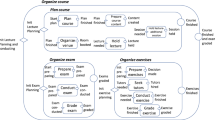Abstract
Business process optimization may require to deviate from a default process model, in response to unexpected situations, thus raising exceptions. In this paper, we present a system for supporting end users in handling exceptions in business process management, which exploits the case-based reasoning (CBR) methodology. CBR offers the advantage of relying on operative knowledge, thus reducing the cost of knowledge elicitation, with respect to other methodologies.
To maintain and organize the case base, we resort to a type of generalized cases, known as prototypes. The use of prototypes allows us to structure the case base itself, thus speeding up retrieval, and avoiding redundancy. In our system prototypes are also intended as a means to help process engineers in defining revised versions of the process schema, in response to frequent exceptions.
The system is currently in use at one of the largest logistics centres in Italy.
Similar content being viewed by others
References
Heimann P, Joeris G, Krapp C, Westfechtel B (1996) Dynamite: dynamic task nets for software process management. In: Proceedings international conference of software engineering, Berlin, pp 331–341
Rinderle S, Reichtert M, Dadam P (2004) Correctness criteria for dynamic changes in workflow systems—a survey. Data Knowl Eng 50:9–34
Aamodt A, Plaza E (1994) Case-based reasoning: foundational issues, methodological variations and systems approaches. AI Commun 7:39–59
Surma J, Vanhoof K (1995) Integration rules and cases for the classification task. In: Veloso M, Aamodt A (eds) Proceedings of the 1st international conference on case-based reasoning, Sesimbra, Portugal, October 1995. Lecture notes in computer science, vol 1010. Springer, Berlin, pp 325–334
Branting LK, Porter BW (1991) Rules and precedents as complementary warrants. In: Proceedings of the of 9th national conference on artificial intelligence, Anaheim, CA, USA, July 1991. AAAI Press, Menlo Park
Bichindaritz I, Kansu E, Sullivan K (1998) Case-based reasoning in care-partner: Gathering evidence for evidence-based medical practice. In: Smyth B, Cunningham P (eds) Proceedings of the 4th European workshop on case-based reasoning, Dublin, Ireland, September 1998. Lecture notes in computer science, vol 1488. Springer, Berlin, pp 334–345
Gierl L, Stengel-Rutkowski S (1994) Integrating consultation and semi-automatic knowledge acquisition in a prototype-based architecture: experiences with dysmorphic syndromes. Artif Intell Med 6:29–49
Kolodner JL (1993) Case-based reasoning. Morgan Kaufmann, San Mateo
Watson I (1997) Applying case-based reasoning: techniques for enterprise systems. Morgan Kaufmann, San Mateo
Zhu J, Yang Q (1999) Remembering to add: competence-preserving case-addition policies for case base maintenance. In: Proceedings of the international joint conference on artificial intelligence. Morgan Kaufmann, San Mateo
Smyth B, McKenna E (1999) Building compact competent case bases. In: Lecture notes in computer science, vol 1650. Springer, Berlin, pp 329–242
Leake DB, Smyth B, Wilson DC, Yang Q (eds) (2001) Special issue on maintaining case based reasoning systems. Comput Intell 17(2):193–398
Maximini K, Maximini R, Bergmann R (2003) An investigation of generalized cases. In: Ashley KD, Bridge D (eds) Proceedings of the 5th international conference on case base reasoning (ICCBR’03), Trondheim, Norway, June 2003. Lecture notes in artificial intelligence, vol 2689. Springer, Berlin, pp 261–275
Riesbeck CK, Schank RC (1989) Inside case-based reasoning. Lawrence Erlbaum Associates, Hillsdale
Bergmann R, Wilke W (1996) On the role of abstraction in case-based reasoning. In: Lecture notes in artificial intelligence, vol 1186. Springer, Berlin, pp 28–43
Bareiss E, Porter B, Wier C (1988) Protos: an exemplar-based learning apprentice. Int J Man-Mach Stud 20:549–561
Reinartz T, Iglezakis I, Roth-Berghofer T (2001) On quality measures for case-base maintenance. Comput Intell 17:214–234
Casati F, Ceri S, Pernici B, Pozzi G (1998) Workflow evolutions. Data Knowl Eng 24:211–238
Weber B, Reichert M, Wild W (2006) Case-based maintenance for CCBR-based process evolution. In: Roth-Berghofer T, Goker M, Altay Guvenir H (eds) Proceedings of the European conference on case based reasoning (ECCBR) 2006. Lecture notes in artificial intelligence, vol 4106. Springer, Berlin, pp 106–120
Schmidt R, Gierl L (2001) Case-based reasoning for antibiotics therapy advice: an investigation of retrieval algorithms and prototypes. Artif Intell Med 23:171–186
Lieber J (2002) Strong, fuzzy and smooth hierarchical classification for case-based problem solving. In: van Harmelen F (ed) Proceedings of the 15th European conference on artificial intelligence (ECAI-02), Lyon, France. IOS Press, Amsterdam, pp 81–85
Wilson DR, Martinez TR (1997) Improved heterogeneous distance functions. J Artif Intell Res 6:1–34
Sadiq S, Marjanovic O, Orlowska M (2000) Managing change and time in dynamic workflow processes. Int. J. Coop. Inf. Syst. 9:93–116
VanderAalst W, Basten T (2002) Inheritance of workflows: an approach to tackling problems related to change. Theor Comput Sci 270:125–203
Dittrich KR, Gatziu S, Geppert A (1995) The active database management system manifesto: a rulebase of adbms features. In: Lecture notes in computer science, vol 985. Springer, Berlin, pp 3–20
Beckstein C, Klausner J (1999) A planning framework for workflow management. In: Proceedings of the workshop on intelligent workflow and process management, Stockholm
Madhusudan T, Zhao JL, Marshall B (2004) A case-based reasoning framework for workflow model management. Data Knowl Eng 50:87–115
Luo Z, Sheth A, Kochut K, Miller J (2000) Exception handling in workflow systems. Appl Intell 13:125–147
Minor M, Tartakovski A, Schmalen D, Bergmann R (2008) Agile workflow technology and case-based change reuse for long-term processes. Int J Intell Inf Technol 4(1):80–98
Ciccarese P, Caffi E, Boiocchi L, Halevy A, Quaglini S, Kumar A, Stefanelli M (2003) The newguide project: guidelines, information sharing and learning from exceptions. In: Proceedings of the artificial intelligence in medicine Europe (AIME) 2003. Springer, Berlin, pp 163–167
Wiratunga N, Lamontagne L (2006) In: Workshop on textual case based reasoning: reasoning with text, European conference on case based reasoning (ECCBR), Oludeniz
Author information
Authors and Affiliations
Corresponding author
Rights and permissions
About this article
Cite this article
Montani, S. Prototype-based management of business process exception cases. Appl Intell 33, 278–290 (2010). https://doi.org/10.1007/s10489-009-0165-z
Received:
Accepted:
Published:
Issue Date:
DOI: https://doi.org/10.1007/s10489-009-0165-z




